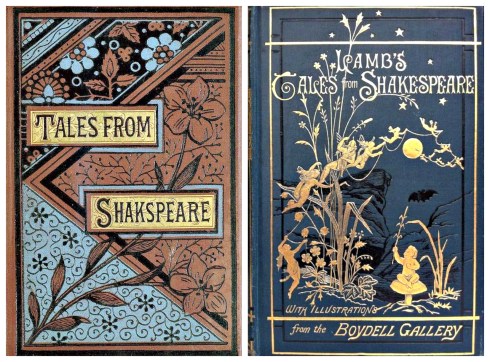The Shakespeare400 happenings were in full swing yesterday, in commemoration of the 400th anniversary of the Bard’s death: April 23 is always a big Shakespeare day because it is the accepted date of his birth and the actual date of his death, and in this particular year yesterday was even BIGGER in Shakespeare world, on both sides of the Atlantic, perhaps even around the Anglophone world. I was thinking about Shakespeare and how I wanted to mark this moment with a post, and there were just too many possibilities: too many historical and cultural sources, too many interesting words and characters, too many deifying moments in centuries past. So I decided to get more personal and focus on my own introduction to Shakespeare, in the form of a classic text titled Tales from Shakespeare first published in 1807 and never out of print thereafter. The Tales was the work of a pair of London siblings, Charles and Mary Lamb, who managed to produce abridged and modernized tales of Shakespeare’s plays despite family tragedy and between bouts of the latter’s insanity (Mary had actually injured her father and murdered her mother a decade earlier while Charles was out of the house; she was released to his care but he kept a straitjacket within easy reach). Charles abridged the tragedies into plain modern prose, and Mary the comedies (!!!); they collaborated on the preface. The first edition, with illustrations taken from copper-plate engravings by William Blake, appeared in 1807 under only his name.



William (and Mary) Lamb, Tales from Shakespeare for the Use of Young Persons, with illustrations based on the copper-plate engravings of William Blake (1807), Folger Shakespeare Library; My edition of Lamb’s Tales from Shakespeare, with illustrations by Karel Svolinsky. Middlesex: Paul Hamlyn (1968).
I use Shakespeare quite a bit in class to illustrate certain aspects of Elizabethan and Jacobean life, and while I will quote his words directly to my students I must admit that I still consult my childhood version of the Tales to figure out exactly what I want to quote from. Or to remind myself: this book gave me a frame of reference to which I can tap into pretty easily, and which I have “filled in” over the years by reading the source plays. I’m sure this is what the Lambs intended, and I’m grateful to them. I also enjoyed learning about the publishing history of their book over a few hours yesterday: obviously I could have spent many more. Following Blake’s example, a succession of illustrated editions issued over the period from about 1860 to 1940 seem to have ensured the continued popularity of the Tales, which eventually became Lamb’s Tales (like my 1960s edition, above). The most accomplished illustrators of their eras embellished glorious editions: Sir John Gilbert in 1866, Arthur Rackham in 1899 and 1909, Louis Monziès in 1908, Walter Paget and Norman Price in 1910, Louis Rhead in 1918, Elizabeth Shippen Green Elliott in 1922, D. C. Eyles in 1934. And then of course there were also mountains of not-so-glorious (in imagery) editions produced “for use in school”: how can we possibly measure the impact of this essential epitome of Shakespeare?






A very poorly proofread Gilbert edition from 1882 and the Boydell Gallery edition from 1900; Title page and illustration from a 1909 Rackham edition; Illustration and front and back matter from 1910 Paget edition; Louis Rhead illustration, 1918; Elizabeth Shippen Green Elliott frontispiece, 1922; variant Puffin Classics editions (with an introduction by Judi Dench).






April 24th, 2016 at 6:10 am
Donna,
What a delightful tribute to the Bard from your childhood memories. Enjoyed reviewing those different editions, particularly liked the illustrated cover from the Boydell Gallery.
Kudos from a retired (sort of) English teacher…
April 24th, 2016 at 6:39 am
Thanks Helen….all the English teachers I know have never retired….
April 24th, 2016 at 2:36 pm
There’s the complication that Elizabethan England used the Julian calendar, whereas we use the Gregorian, so yesterday wasn’t acually the 400th anniversary of Shakespeare;s birth.
April 24th, 2016 at 2:38 pm
Well of course you are correct, Roger! I think this is the first reference to that that I’ve seen in this worldwide celebration……
April 26th, 2016 at 2:06 pm
The same problem comes up with the claim that Shakespeare and Cervantes died on the same day. They didn’t: same date, different days.
April 25th, 2016 at 7:48 pm
I ashamed to say that even as I am a member of the Folger I’ve not gotten around to attending any of their events, so this blog entry makes up for it a bit and inspires me to go next door tomorrow during lunch break and at least check out their exhibit. … But I am reading about Jacobean embroidery!
April 26th, 2016 at 10:46 am
fabulous post – I have loved Shakespeare all my life – he is a hero of mine. I boggle at the impact he had on the world – and on mine – he jumpstarted my love of literature and language. To consider he was so intuitive about human nature and such a communicator still amazes me. I made my own handmade tribute book
to him a couple of years ago which has proved quite popular in my Etsy store!
April 26th, 2016 at 10:49 am
I’ll check it out, thanks!
April 30th, 2016 at 2:53 pm
While my introduction to Shakespeare was Zeffirelli’s movie adaptation of “Romeo and Juliet,” inescapable in those days.
Nitpick: you refer to Blake’s illustrations in the text, but the caption following reads “William Black” instead. I hope this does not mean you are a closet Baconian!
April 30th, 2016 at 3:03 pm
Thanks Brian! Love Zeffirelli’s film–really beautiful.